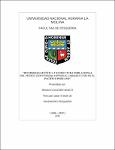Mostrar el registro sencillo del ítem
Diversidad genética y estructura poblacional del perico (Coryphaena hippurus, Linnaeus 1758) en el Pacífico Peruano
| dc.contributor.advisor | Mendo Aguilar, Jaime Humberto | |
| dc.contributor.author | Gozzer Wuest, Renato | |
| dc.date.accessioned | 2016-09-16T19:11:04Z | |
| dc.date.available | 2016-09-16T19:11:04Z | |
| dc.date.issued | 2015 | |
| dc.identifier.other | L10.G69-T BAN UNALM | |
| dc.identifier.uri | https://hdl.handle.net/20.500.12996/1912 | |
| dc.description | Universidad Nacional Agraria La Molina. Facultad de Pesquería. Departamento Académico de Manejo Pesquero y Medio Ambiente | es_PE |
| dc.description.abstract | El perico (Coryphaena hippurus) es un predador tope oportunista, cosmopolita, de rápido crecimiento y madurez y alta fecundidad. Perú, entre el 2008 y 2012, ha mantenido desembarques anuales del orden del 50% del total mundial. A pesar de la importancia de esta pesquería, tanto para la seguridad alimentaria del país como para las exportaciones pesqueras, ésta no cuenta con un plan de manejo y no se han definido científicamente los stocks pesqueros, base para delimitar la(s) población(es) a ser manejada(s). En este estudio se colectaron 241 muestras de tejido en las principales zonas de pesca en siete localidades del pacífico peruano (Sechura, Huanchaco, Chimbote, Casma, Végueta, Ica Sur y Tacna Sur) durante los meses de enero y febrero del año 2014. Se amplificaron y genotipificaron cinco loci de microsatélites polimórficos para cada uno de los individuos de estas localidad y se calcularon índices de diversidad genética y estructuración poblacional. Los resultados mostraron una alta diversidad genética, indicio de buena salud genética del recurso. El análisis Fst por pares de poblaciones y los análisis moleculares de varianza – AMOVAs mostraron estructuración poblacional sutil pero significativa (Fst = 0,009 y p-value = 0,000). El sur del país mostró niveles significativos de diferenciación con respecto al resto de localidades (0,0093 < Fst < 0,0287 y p-value = 0,000). Los análisis de asignación bayesiana sugirieron estructuración poblacional en dos clusters. El análisis de componentes principales (PCA) falló en el agrupamiento por componentes, no mostrando evidencias de existencia de más de una subpoblación. | es_PE |
| dc.description.abstract | Mahi mahi (Coryphaena hippurus) is an opportunistic and cosmopolitan top predator, which presents fast growth and maturity, as well as high fertility. Annual landings in Peru between 2008 and 2012 remained around 50% of the world total. Despite the importance of this fishery both for Peru’s food safety as for its exports, it still does not have a management plan and fish stocks have not yet been scientifically defined, which is the basis to identify and establish the population(s) to be managed in the first place. In this study, 241 tissue samples were collected in seven localities of the Peruvian coast (Sechura, Huanchaco, Chimbote, Casma, Végueta, South of Ica and South of Tacna), between January and February of 2014. To measure genetic diversity and population structure from these samples, five highly polymorphic microsatellite loci were amplified and genotyped for each individual, and indices of genetic diversity and population structure were calculated. The results showed high genetic diversity, indicating that in Peru mahi mahi has good genetic health. The pairwise Fst analysis of populations and analysis of molecular variance - AMOVAs showed a subtle but significant population structure (Fst = 0.009 and p-value = 0.000). Tacna Sur showed significant levels of differentiation with respect to other locations (0.0093 < Fst < 0.0287 y p-value = 0.000). Bayesian analysis of population structure suggested allocation into two clusters. The principal component analysis (PCA) failed in the grouping components, showing no evidence of the existence of more than one subpopulation. | en_US |
| dc.description.uri | Tesis | es_PE |
| dc.format | application/pdf | en_US |
| dc.language.iso | spa | es_PE |
| dc.publisher | Universidad Nacional Agraria La Molina | es_PE |
| dc.rights | info:eu-repo/semantics/openAccess | en_US |
| dc.rights.uri | https://creativecommons.org/licenses/by-nc-nd/4.0/ | * |
| dc.source | Universidad Nacional Agraria La Molina | es_PE |
| dc.source | Repositorio institucional - UNALM | es_PE |
| dc.subject | Diversidad genética | es_PE |
| dc.subject | Manejo pesquero | es_PE |
| dc.subject | Coryphaena hippurus | es_PE |
| dc.subject | Perico | es_PE |
| dc.subject | Perú | es_PE |
| dc.subject | Coryphaena | es_PE |
| dc.subject | Peces marinos | es_PE |
| dc.subject | Biodiversidad | es_PE |
| dc.subject | Recursos genéticos | es_PE |
| dc.subject | Estructura de la población | es_PE |
| dc.subject | Evaluación de poblaciones | es_PE |
| dc.subject | Marcadores genéticos | es_PE |
| dc.subject | Microsatélites | es_PE |
| dc.subject | Evaluación | es_PE |
| dc.subject | Océano Pacifico | es_PE |
| dc.title | Diversidad genética y estructura poblacional del perico (Coryphaena hippurus, Linnaeus 1758) en el Pacífico Peruano | es_PE |
| dc.type | info:eu-repo/semantics/bachelorThesis | en_US |
| thesis.degree.discipline | Manejo Pesquero y Medio Ambiente | es_PE |
| thesis.degree.grantor | Universidad Nacional Agraria La Molina. Facultad de Pesquería | es_PE |
| thesis.degree.name | Ingeniero Pesquero | es_PE |
| thesis.degree.level | Título Profesional | es_PE |
Ficheros en el ítem
Este ítem aparece en la(s) siguiente(s) colección(ones)
-
PES-MP Tesis [62]



